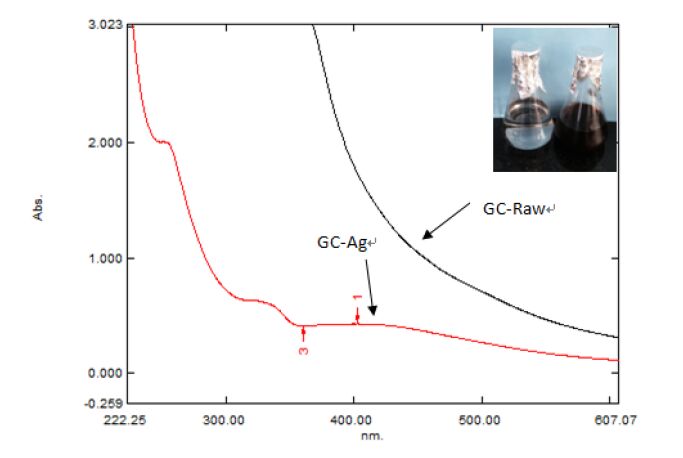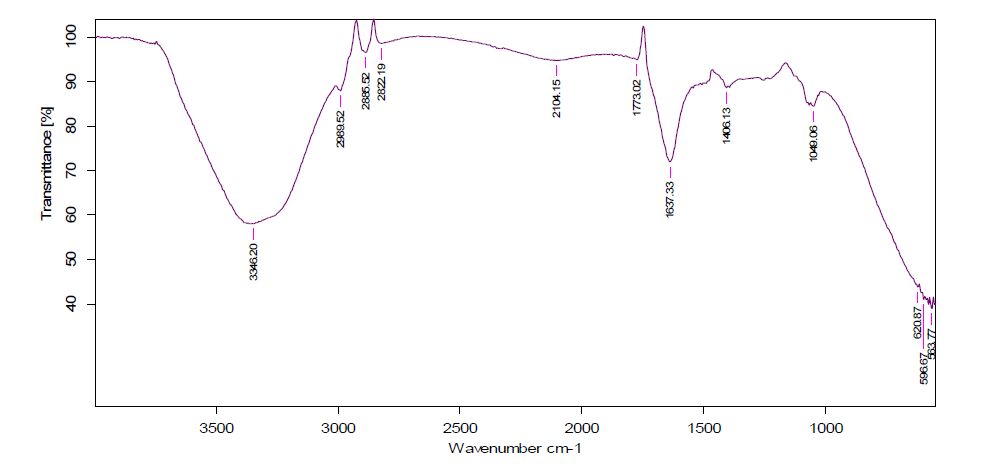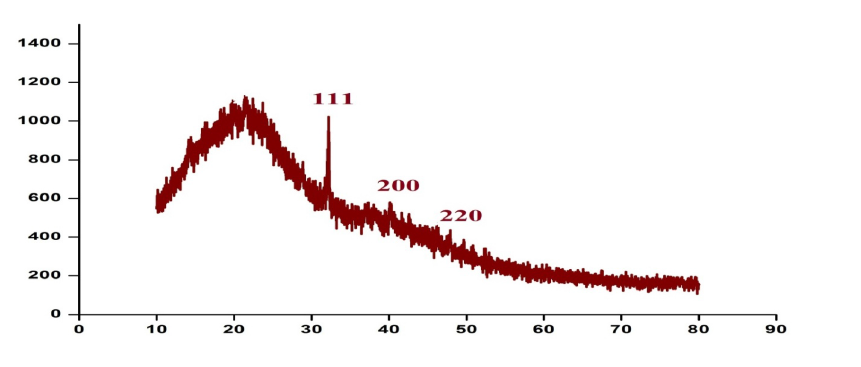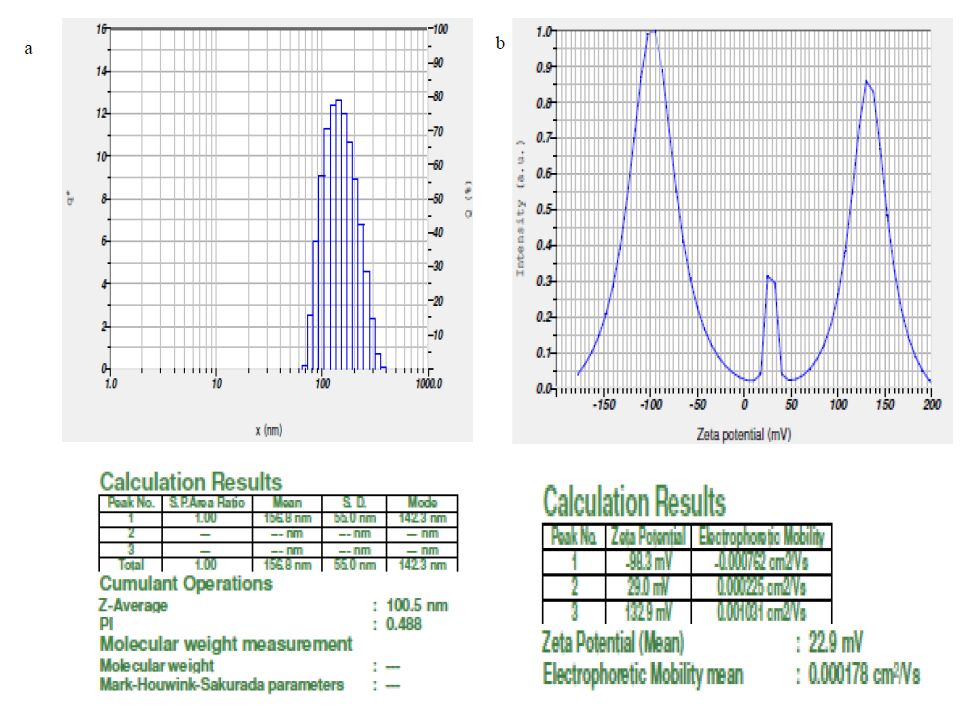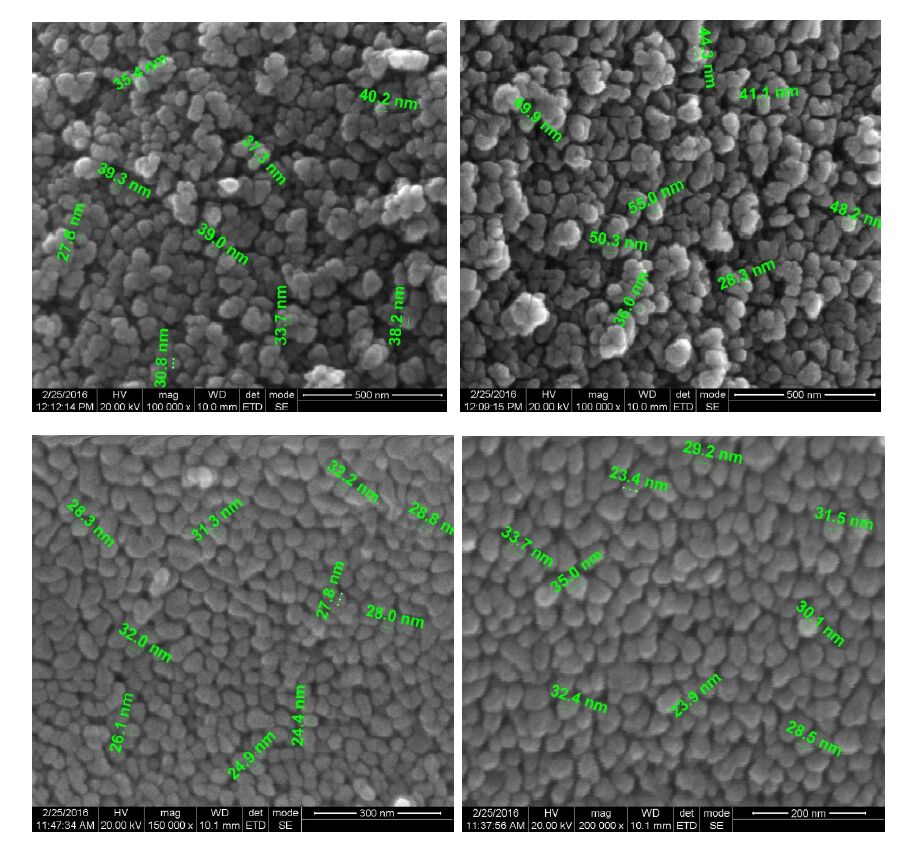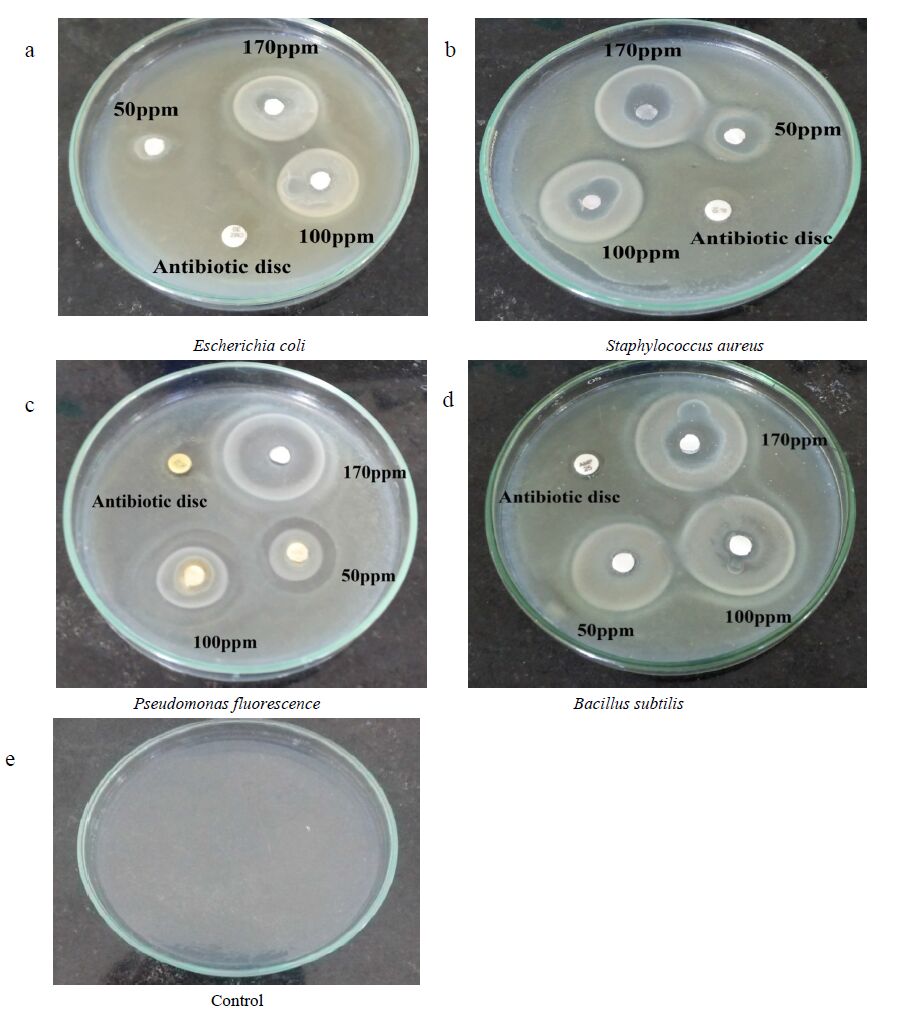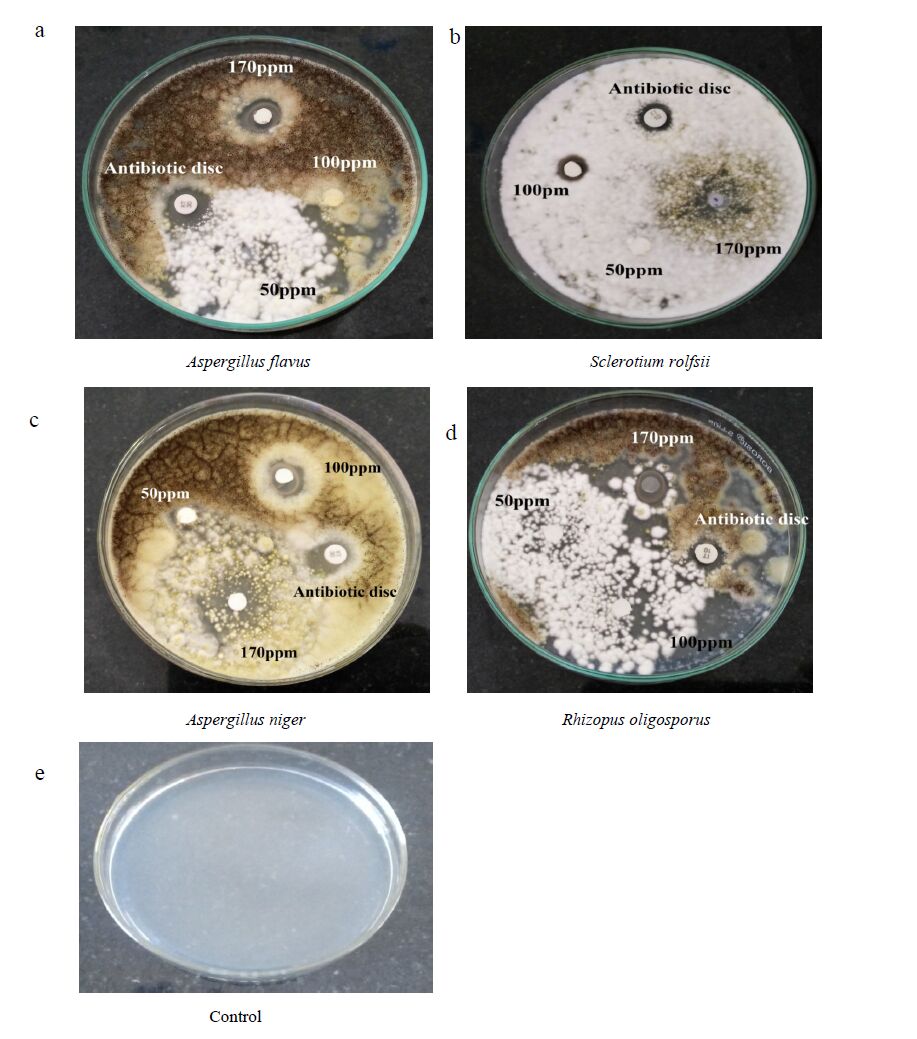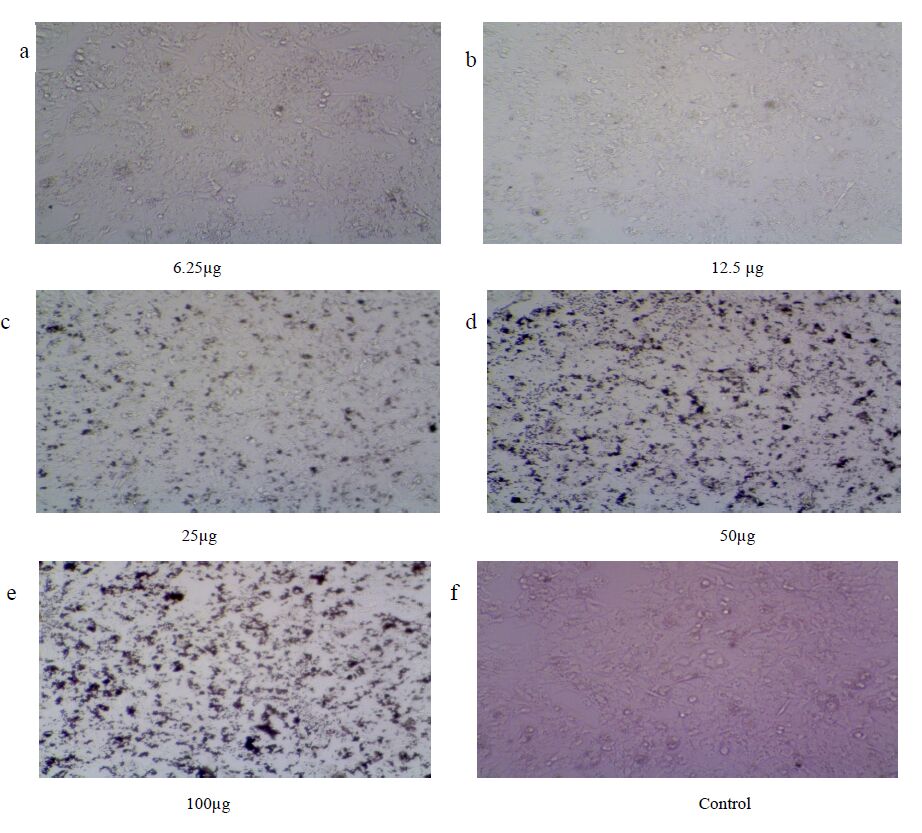1. Introduction
Development of effective therapeutics largely dependent on the challenges posed by the drug-resistant microbes and their control. The metallic nanoparticles (measured length is less than 100 nm in at least one dimension) were proved to be the most promising and remarkable biomedical agents. It is due to their large surface to volume ratio they pose interesting properties in respect of microbial resistance. Among the developed nanoparticles, silver (Ag) nanoparticles carved the niche of medicine, therapeutics in particular. Recently, abundant reports [1,2,3,4] were available on use of biological organisms like microbes, plants and seaweeds for the synthesis of Ag nanoparticles and their antimicrobial properties were illustrated with possible mechanistic aspects [5].
Silver in its pure form was known as a great material to keep microbes at bay. If silver is transformed into a nanoparticle, this anti-microbial property is intensified, making it useful in effectively containing fungus, bacteria, and viruses. As a natural material, silver is known to be safe to man and produce little to no allergic reactions when tested for curing various diseases. Given its broad spectrum activity, AgNPs have been the focus of increasing interest and are being used as an excellent candidate for therapeutic purposes [6].
Cancer is an abnormal growth of tissue or cells exhibiting uncontrolled division autonomously resulting in a progressive increase in the number of cell divisions [7]. There is an increasing demand for anticancer therapy [8,9]. The fight against cancer is difficult particularly in the development of therapies for severely multiplying tumors. Chemotherapy is available for treatment of cancer but still it exhibits low specificity and is restricted by dose limiting toxicity. It is a challenge to find the therapy and drugs for the treatments of various types of cancers. So, conventional methods require the combination of controlled released technology and targeted drug delivery which is more effective and less harmful. Nanomaterials are expected hopefully to revolutionize cancer diagnosis and therapy. Recently, the anticancerous efficacies of silver nanoparticles synthesized through different sources were evaluated against Hep2 cell line [10,11], HT-29 cell lines [12], Vero cell line [13] and breast cancer line MCF-7 [14].
During the past three decades, research on seaweeds has been increased considerably in the search of new and effective medicines of natural origin. Several compounds include primary and secondary metabolites synthesized by seaweeds are promising source for both industrial and biotechnological applications [15]. Gracilaria corticata is a predominant red seaweed species found in coastal regions of Indian subcontinent, belonging to the family Gracilariacea (Figure 1). It possess several biomedical properties such as antibacterial, antiviral, antifungal, antiprotozoal, anti-inflammatory, anti-oxidant, cytotoxic, contraception, gastrointestinal, cardiovascular, hypoglycemia, anti-enzymes, spasmolytic and allelophatic effects [16].
In the present study, silver nanoparticles were prepared using a naturally occurring red marine algae (Gracilaria corticata), which acted as both the reducing and stabilizing agents. This approach not only utilizes an abundant regional resource, but also falls within the scope of green synthesis for AgNPs that could allow scalability of the process to industrially relevant applications. In addition, we evaluated the antimicrobial activity of the synthesized NPs against representative strains and also anticancerous activity.
2. Materials and Methods
2.1. Materials
The required materials for the experimentation were Silver nitrate (Sigma Aldrich 99%), to prepare the metal salt solution, Nutrient broth, Potato dextrose broth, Potato dextrose agar, and Nutrient agar plate (Hi-media, India) and used as they received without any further purification.
2.2. Preparation of Gracilaria corticata (red algae) extract
The red algae (Gracilaria corticata) were collected from the Rameshwaram (Longitude 79˚12’30” E and Latitude 9˚8’55” N) sea coast area, Tamilnadu, India and were washed with distilled water several times to remove the impurities. The clean algae were dried at room temperature in the shade for a week and powdered using a mortar and pestle. Dried powder of Gracilaria corticata (5 g) was added with 100 ml distilled water and the solution was boiled at 100 °C for 1 h. Then the extract was filtered (using Whatman No.1 filter paper) and was collected and stored at 4 °C for further use.
2.3. Synthesis of silver nanoparticles from Gracilaria corticata
To prepare silver nanoparticles, 90 ml of aqueous solution of 1 mM Silver nitrate was added to 10 ml of the aqueous extract of Gracilaria corticata to make the total volume to 100 ml. After 24 h of aging the colour of the solution was changed to dark brown which indicates the formation of AgNPs and the hydrosol (solution containing nanoparticles) was used for further characterization and applications.
2.4. Collection of microbes (bacteria and fungi)
The microbes (bacteria and fungi) samples were collected from Nanotechnology laboratory, Regional Agricultural Research Station, Tirupathi, Andhra Pradesh, India. Fungal sp. was isolated using potato dextrose agar (PDA) medium through serial dilution pour plate technique. Gram negative and Gram-positive bacteria were isolated from nutrient agar medium and prepared the respective agar slants for onward analysis.
2.5. Antibacterial activity of Gracilaria corticata produced AgNPs
The antibacterial activity of AgNPs was evaluated against the pathogenic strains E. coli, Pseudomonas Fluorescence, Staphylococcus aureus and Bacillus subtilis. These cultures were grown in appropriate mediums at 37 °C for overnight incubation and maintained at 4 °C in a refrigerator. Disc (for disc diffusion method) of 5mm was made for nutrient agar medium and each disc was dipped at different concentrations (170, 100, 50 ppm) of prepared AgNPs. The pure cultures of bacterial pathogens were sub-cultured in an appropriate medium. For comparison, plate of the same diameter with 5 mm penicillin-g (30 mcg) was used. After incubation at 37 °C for 24 h the bacterial inhibition zones were calculated. These assays were performed in triplicate.
2.6. Antifungal activity of Gracilaria corticata produced AgNPs
The antibacterial activity of AgNPs was evaluated against the pathogenic strains Aspergilus niger, Aspergilus flavus, Schelorosium rolfsii, and Rhizopus oligosporus. These cultures were grown in appropriate medium at 37 °C for overnight incubation and maintained at 4 °C in a refrigerator. Disc of 5 mm was made on nutrient agar medium and each disc was dipped at different concentrations (170, 100, 50 ppm) of AgNPs. The pure cultures of fungal pathogens were sub-cultured in an appropriate medium and each strain was swabbed uniformly on to the individual plate. For comparison, plate of the same diameter with 5 mm itraconazole (30 mcg) was used. After incubation at 37 °C for 24 h the inhibition zones were measured in triplicate.
2.7. Anticancer activity of Gracilaria corticata produced AgNPs using human hepatic carcinoma (HepG2) cell line and treatment procedure
The human hepatic carcinoma cell line (HepG2) was obtained from National Centre for Cell Science (NCCS), Pune, India and grown in Eagles Minimum Essential Medium containing 10% fetal bovine serum (FBS). The cells were maintained at 5% CO2 and incubated at 37 °C for 24 hours.
After 24 h the cells were treated with serial concentrations of the test sample (Ag nanoparticles) (6.25, 12.5, 25, 50, and 100 µg/ml) and placed in the humidified 5% CO2 incubator for 48 h. Cells incubated in culture medium alone served as a control for cell viability (untreated wells). Each experiment was repeated at least three times. After Ag nanoparticles treatment, cells were aspirated by 600 µL of phosphate buffer saline (PBS) (pH 7.0) and centrifuged for 10 min at 3000 rpm to remove cell debris and obtain a clear supernatant.
2.8. MTT assay
The MTT assay is a colorimetric assay for measuring the activity of cellular enzymes that reduce the tetrazolium dye, MTT, to its insoluble formazan, giving a purple color. MTT (3-(4, 5- dimethylthiazol-2-yl)-2, 5-diphenyltetrazolium bromide, a yellow tetrazole), is reduced to purple formazan in living cells. After 48 h of incubation, 15 µl of MTT (5 mg/ml) in phosphate buffered saline (PBS) was added to each well and incubated at 37 °C for 4 h. The medium with MTT was then flicked off and the formed formazan crystals were solubilized in 100 µl of DMSO and then measured the absorbance at 570 nm using micro plate reader. The percentage cell viability was then calculated with respect to control as follows
2.9. Characterization of Ag nanoparticles using UV-Visible spectral analysis
Nanoscale particles exhibit the localized surface plasmon resonance (LSPR) phenomenon which represents the characteristic absorption spectra of the nanoparticles (formed silver nanoparticles) and was recorded using UV-Vis Spectrophotometer (50 ANALYTIKJENA) run in the wavelength range from 250 to 400 nm.
2.10. Fourier Transform-Infrared spectroscopic (FT-IR) analysis
The FT-IR spectrum of the sample containing silver nanoparticles was recorded by directly placing KBr crystal using ATR (attenuated total reflectance) technique in the transmittance mode and run in the mid IR region of 400-4000 cm-1.
2.11. X-ray diffraction analysis and crystal structure determination
X-ray diffraction technique was used to reveal the crystal structure of the prepared silver nanoparticles. The XRD pattern was recorded using computer controlled XRD-system (JEOL Model: JPX-8030) with CuK radiation (Ni filtered = 13418 Ao) at 40 kV, 20 A. The ‘peak search’ and ‘search match’ program built in software (syn master 7935) was used to identify the peak table and ultimately for the identification of XRD peak.
2.12. Hydrodynamic diameter (HDD) and Zeta potential analysis
The hydrosol was filtered through a 0.22 μm syringe driven filter unit and the size (hydrodynamic diameter) and distribution were measured by using the Dynamic Light Scattering (DLS) technique (Nanopartica, HORIBA, SZ-100).
2.13. Scanning Electron Microscopic (SEM) studies
The surface morphological studies including size and shape of the formed silver nanoparticles were carried out by analyzing the samples under scanning electron microscope (Hitachi's SU6600) operated at accelerating voltage of 30 Kv (with the magnification ranging from 10× to 600,000× ).
3. Results and Discussion
3.1. UV-Visible spectral analysis
It is well-known that silver nanoparticles exhibit brown color, which arises due to excitation of surface plasmon vibrations caused by resonance. After addition of 1 mM silver nitrate solution to the red algae aqueous extract, the colour of the composition was changed to dark brown. The conversion of silver ions into silver nanoparticles was observed after 24 h of aging of the mixed solution. The characteristic UV-Vis absorbance peak was observed at 405 nm for silver nanoparticles synthesized using Gracilaria corticata extract (Figure 2).
3.2. Fourier Transform Infrared (FT-IR) spectrometric analysis
FT-IR spectrum represents the molecules responsible for the reduction and stabilization of AgNPs using Gracilaria corticata extract (Figure 3). The peak at 3346 cm-1 reveals N-H stretching, representing the presence of primary and secondary amines. The peak at 2989 cm-1 reveals the C-H stretching vibration, indicating the presence of carboxylic / phenolic groups. The peaks correspond to 2885, 2822 cm-1 reveals C-H stretching vibration, indicating the presence of alkanes. The peak at 2104 cm-1 reveals stretching of -C ≡ C-indicating the presence of alkynes and the peaks at 1773 and 1637 cm-1 indicating the presence of [N-H] C = O group. The association of poly phenols with synthesized AgNPs was revealed with the presence of amide II and amide III of aromatic rings corresponds to the peak at 1408 cm-1. The peaks at 620, 598 and 583 cm-1 indicating C-Br stretching vibration of alkyl halides.
3.3. X-Ray diffraction analysis
X-Ray diffraction analysis of dry powder obtained from the formed silver nanoparticles was carried out to reveal the structural details. The diffraction intensities were recorded from 10°-80° of 2θ angles (Figure 4). Four characteristic peaks were observed at 2θ of 38.6°, 45.8° and 49.8° corresponds to (111), (200) and (220) lattice planes, respectively. All these peaks in XRD pattern can be readily indexed to a face centered cubic structure of silver (JCPDS, File No. 4-0783). The XRD pattern of these peaks indicates the AgNPs were crystalline in nature and some of the unassigned peaks were observed it may be due to the fewer bio-molecules of stabilizing agents or enzymes or proteins in the Gracilaria corticata extract.
3.4. Dynamic light scattering analysis
The hydrodynamic diameter (size) of the Gracilaria corticata AgNPs was found to be 100.5 nm (Figure 5a) and was measured as a function of scattering angle of the laser from the surface of the particle. Further, zeta potential of AgNPs was also measured and was recorded as 22.9 mV (Figure 5b).The higher zeta potential (22.9 mV) clearly indicates the dispersity and stability of the prepared AgNPs.
3.5. Scanning Electron Microscopy analysis
Surface morphology of Gracilaria corticata extract mediated silver nanoparticles was studied from the SEM micrograph. It is evident that AgNPs were spherical in shape and were poly-dispersed. The measured average size of AgNPs was 55 nm and occasional agglomeration of the AgNPs has been observed (Figure 6).
3.6. Antimicrobial activity of Gracilaria corticata aqueous extract mediated silver nanoparticles
It is well-known that silver nanoparticles exhibit brown color, arising due to excitation of surface Plasmon vibrations in the silver nanoparticles. Silver nanoparticles obtained from Gracilaria corticata shown have very strong inhibitory action against fungal sp, Gram-positive and Gram-negative bacteria. Three concentrations of NPs (170, 100, 50 ppm) were prepared and were applied against an array of bacterial species viz., Escherichia coli, Staphylococcus aureus, Pseudomonas fluorescence and Bacillus subtilis, fungal species viz., Aspergillus flavus, Sclerotium rolfsii, Aspergillus niger and Rhizopus oligosporus. The higher concentration (170 ppm) of AgNPs showed significant antimicrobial effect compared with other concentrations (100 and 50 ppm).
The mechanism by which the nanoparticles are able to penetrate the bacteria is not understood completely, but studies suggest that when bacteria were treated with silver nanoparticles, changes took place in its membrane morphology that produced a significant increase in its permeability affecting proper transport through the plasma membrane, leaving the bacterial cells incapable of properly regulating transport through the plasma membrane, resulting into cell death [17]. It is observed that silver nanoparticles have penetrated inside the bacteria and have caused damage by interacting with phosphorus- and sulfur-containing compounds such as DNA (Figure 7 and 8), (Table 1 and 2) the findings in this study may lead to the development of AgNPs-based new antimicrobial systems for medical applications.
Table 1. In vitro antibacterial studies against bacteria using Gracilaria corticata extract mediated silver nanoparticles as inhibitors
| S.no
|
Bacteria
|
Zone of inhibition recorded with different concentrations of Gracilaria corticata (red algae) aqueous extract mediated silver nanoparticles
|
|
170 ± 1.4ppm
|
100 ± 1.1ppm
|
50 ± 0.8ppm
|
Cefmetazole 30mcg
|
|
1
|
Escherichia Coli
|
2.0 ± 0.2
|
1.0 ± 0.3
|
0.8 ± 0.2
|
0.5 ± 0.2
|
|
2
|
Staphylococcus aureus
|
3.1 ± 0.7
|
2.6 ± 0.5
|
0.9 ± 0.1
|
1.3 ± 0.5
|
|
3
|
Pseudomonas fluorescence
|
3.7 ± 1.2
|
3.3 ± 1.4
|
1.0 ± 0.3
|
2.1 ± 0.4
|
|
4
|
Bacillus subtilis
|
3.3 ± 1.4
|
2.5 ± 0.6
|
0.6 ± 0.2
|
1.8 ± 0.3
|
| *The presented data are the mean (n = 3) ± standard error of three replicates. |
Table 2. In vitro antifungal studies against fungi using Gracilaria corticata extract mediated silver nanoparticles as inhibitors
| S.no
|
Fungi
|
Zone of inhibition recorded with different concentrations of Gracilaria corticata (red algae) aqueous extract mediated silver nanoparticles
|
|
170 ± 1.4ppm
|
100 ± 1.1ppm
|
50 ± 0.8ppm
|
Itraconazole 30mcg
|
|
1
|
Aspergillus flavus
|
1.1 ± 0.4
|
0.5 ± 0.02
|
0.3 ± 0.02
|
1.5 ± 0.3
|
|
2
|
Sclerotium rolfsii
|
1.1 ± 0.5
|
0.8 ± 0.04
|
0.5 ± 0.03
|
1.8 ± 0.4
|
|
3
|
Aspergillus niger
|
2.1 ± 0.6
|
1.8 ± 0.2
|
0.4 ± 0.04
|
1.6 ± 0.2
|
|
4
|
Rhizopus oligosporus
|
1.2 ± 0.7
|
0.7 ± 0.3
|
0.5 ± 0.03
|
0.8 ± 0.04
|
| *The presented data are the mean (n=3) ± standard error of three replicates |
3.7. MTT Assay
The in-vitro cytotoxic effects of AgNPs were screened against HepG2 cell line and the percentage of cell inhibition was confirmed by MTT assay (Table 3). After 48 h of treatment, the AgNPs at concentration of 0.25 µg/ml shown 99.2 viability, 2.5 µg/ml shown 99.1, 25 µg/ml shown 94.5, 50 µg/ml shown 89.5 and 100 µg/ml shown 77.4 of viability of HepG2 cells, and this was chosen as IC50 (Figure 9). The cytotoxic effects of AgNPs are the active physico-chemical interaction of silver atoms with the functional groups of intracellular proteins, nitrogen bases and phosphate groups in DNA. Although, further studies are needed to fully understanding the mechanism involved in the anticancer activity. From our results, it can be concluded that the Gracilaria corticata nanoparticles could have induced intracellular reactive oxygen species generation, which can be evaluated using intracellular peroxide-dependent oxidation and caused cell death slightly. The control cells were clustered, healthy and viable cells the Gracilaria corticata silver nanoparticles treated cells showed slightly increased apoptosis morphological changes also the clearly visible cell debris is due to cell death at dose of 12.5 µg/ml silver nanoparticles treatment. Further studies have to be carried out to understand the nature of cytotoxicity and the death or proliferation of cells caused by Gracilaria corticata extract mediated silver nanoparticles [18,19].
In this work, the possible explanation of difference in the reduction time could be due to the difference in their reduction potential for the metal ions. Metal nanoparticles such as silver have free electrons, which give rise to SPR absorption band at and around 405 nm. The reduction and stabilization of silver ions could be done by combinations of biomolecules found in the algal extracts, such as proteins, amino acids and polysaccharides which are evidenced in FT-IR studies amines are a particularly attractive class of reducing agents because of their structural or chemical properties, In addition to the Bragg peaks representative of FCC AgNPs, additional as yet unassigned peaks are also observed suggesting that the crystallization of bio-organic phase occurs on the surface of the nanoparticles. The size distribution by volume gives a bell shaped pattern which indicates the wide range size distribution of nanoparticles in the sample formulation. The TEM images have shown that the formed AgNPs were polydispersed and were predominately spherical in nature
The silver nanoparticles were biologically synthesized from Gracilaria corticata extract and the method proved to be economical and environmentally benign. These well defined phycogenic silver nanoparticles showed enhanced antimicrobial properties against an array of bacterial and fungal species. The previous in vitro cytotoxic studies proved that Ag-NPs have dose-dependent cytotoxic effects on human liver HepG2 cells due to trigger of oxidative stress and induction of apoptosis, mediated by mitochondrial injury via the generation of reactive oxygen species or increases in intracellular oxidative stress and trigger cell death process including apoptosis and necrosis [20].
Table 3. Cytotoxic activity of Gracilaria corticataAgNPs against Human hepatic carcinoma cell line (HepG2)
| S.No
|
Conc (µg/ml)
|
% Cell viability
|
|
1
|
0.25
|
99.2
|
|
2
|
2.5
|
99.1
|
|
3
|
25
|
94.5
|
|
4
|
50
|
89.5
|
|
5
|
100
|
77.4
|
The anticancer effect of silver nanoparticles against HepG2 lines was performed the results show the good cytotoxic activity against the cancer cells. The concentration of silver nanoparticles plays an important role in the anticancer activity. The silver nanoparticles are having the good results followed by 0.25 µg/ml, 2.5 µg/ml, 25 µg/ml, 50 µg/ml and 100 µg/ml. The lowest inhibitory action was observed form the concentration of 100 µg/ml. Our study describes the potential use of Gracilaria corticata (Sea Weed) as a source of anti-cancer drug. The aqueous extract of the sea weed was tested for its cytotoxicity and apoptotic properties against the hepatocellular carcinoma (HepG2) cells in vitro. The anticancer activity was observed and that the synthesized silver nanoparticles induce a dose dependant inhibition activity against HepG2 cells. Some of the approved chemotherapeutic agents were caused side effect and high cast. Therefore there is an important need to develop alternative medicines against this deadly disease. Biosynthesis of silver nanoparticles using Gracilaria corticata extract was developed in a very simple and eco-friendly method. Generally, sea weeds containing proteins have played a major role in acting as a reductant as well as a capping material in order to synthesize AgNPs that functioned effectively as an anticancer agent against HepG2 cancer cells.
4. Conclusions
Herein, aqueous extract of Gracilaria corticata was used to synthesize well defined silver nanoparticles and were triggered cell death in HepG2 through apoptosis. The prepared silver nanoparticles were also shown excellent antimicrobial properties against an array of microbes. Thus, our results show that Gracilaria corticata mediated AgNPs have proved to be potential for use as one of the cancer chemotherapeutic agents, as well as it serve as a source to produce potential anticancerous drugs supportive therapy during etoposide treatment.
Acknowledgements
Research facilities provided by Acharya N G Ranga Agricultural University (ANGRAU) at Institute of Frontier Technology, Regional Agricultural Research Station, Tirupati were used to carry out part of this research work and authors acknowledge ANGRAU for the same.
Conflict of Interest
The authors declare no conflict of interest.









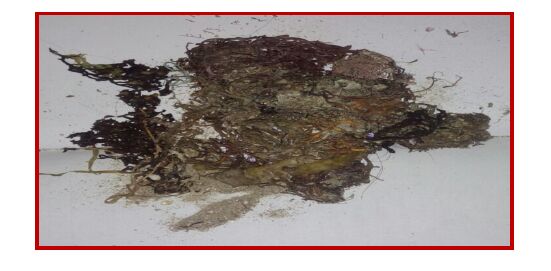
 DownLoad:
DownLoad: 